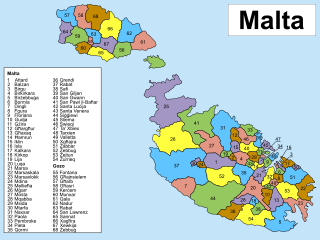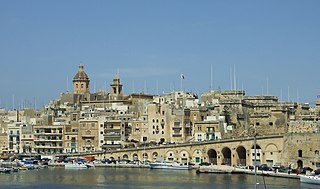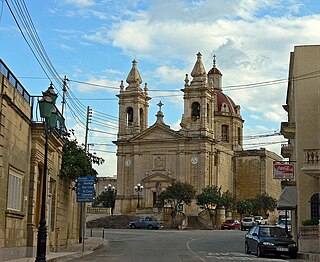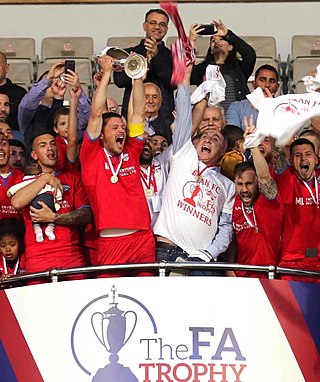

This is a list of local councils of Malta which have standing links to local communities in other countries known as "town twinning" (usually in Europe) or "sister cities" (usually in the rest of the world).


This is a list of local councils of Malta which have standing links to local communities in other countries known as "town twinning" (usually in Europe) or "sister cities" (usually in the rest of the world).
Marsaskala is a member of the Douzelage, a town twinning association of towns across the European Union, alongside with: [15]
Nadur is a member of the Charter of European Rural Communities, a town twinning association across the European Union. [22] Nadur also has two other twin towns. [23]
Charter of European Rural Communities
Other

Valletta is the capital city of Malta and one of its 68 council areas. Located between the Grand Harbour to the east and Marsamxett Harbour to the west, its population as of 2021 was 5,157. As Malta’s capital city, it is a commercial centre for shopping, bars, dining, and café life. It is also the southernmost capital of Europe, and at just 0.61 square kilometres (0.24 sq mi), it is the European Union's smallest capital city.

Since June 30, 1993, Malta has been subdivided into 68 localities, governed by local councils, Maltese: kunsilli lokali, meaning municipalities or borough, and the considered by the Maltese as the equivalent to a basic village or towns, where appropriate. These form the most basic type of local government and are subdivisions of the country's first-level regions.

Birgu, also known by its title Città Vittoriosa, is an old fortified city on the south side of the Grand Harbour in the South Eastern Region of Malta. The city occupies a promontory of land with Fort Saint Angelo at its head and the city of Cospicua at its base. Birgu is ideally situated for safe anchorage, and over time it has developed a very long history with maritime, mercantile and military activities.

Senglea, also known by its title Città Invicta, is a fortified city in the South Eastern Region of Malta. It is one of the Three Cities in the Grand Harbour area, the other two being Cospicua and Vittoriosa, and has a population of approximately 2,720 people. The city's title Città Invicta was given because it managed to resist the Ottoman invasion at the Great Siege of Malta in 1565. The name Senglea comes from the Grand Master who built it Claude de la Sengle and gave the city a part of his name. While Senglea is the 52nd most populated locality on the island, due to its incredibly small land area, it is the 2nd most densely populated locality after Sliema.

Żebbuġ is a village and an administrative unit of Malta, in the northwest coast of the island of Gozo. It is located close to Għarb and Għasri and is built on two hilltop plateaus, Ta' Abram and Ix-Xagħra taż-Żebbuġ. The fishing port and tourist resort of Marsalforn lies within the Żebbuġ Council. The village has a population of 2,956, which makes it the fifth largest in Gozo, after Xewkija.

Santa Venera is a town in the Southern Region of Malta, with a population of 8,834 (2021). It is located between the towns of Birkirkara and Ħamrun, and also borders Qormi and Msida.

Żebbuġ, also known by its title Città Rohan, is a city in the Southern Region of Malta. It is one of the oldest towns in the country, and its population is 11,074 as of June 2021.

Xgħajra is a small village in the South Eastern Region of Malta. It is located on the coast, about halfway between Valletta and Marsaskala. Its local football club is known as the Xgħajra Tornadoes F.C. Contrary to popular belief, it has no relation to the Gozitan village Xagħra. Its population stood at 1,732 in March 2014.

Sannat is an administrative unit of Malta, on the island of Gozo, with a population of 2,117 people. Ta' Sannat is in the south of Gozo, popular for its very high cliffs, ancient cart ruts, temples and dolmens, and rich fauna and flora. In 1951 The Duchess of Edinburgh of the United Kingdom visited a house called "The Lace house" located in a small square in Ta' Sannat called "Pjazza Tax-Xelina".

Xewkija is an administrative unit and village of Malta, on the island of Gozo. The population of Xewkija is 3,300 as of March 2014.

Malta is for non-local government purposes divided into districts as opposed to the local government regions at the same level. The three main types of such districts – statistical, electoral at national level, and policing – have no mainstream administrative effect as the regions and local councils function as the only administrative divisions of the country.
This page list topics related to Malta.

Local elections were held in Malta on 8 March 2008, the same day of the general election. This year, the election was held in 23 of the 68 Maltese localities. These 23 localities are: Valletta, Senglea, Żebbuġ, Żejtun, Balzan, Dingli, Fontana, Għajnsielem, Għasri, Iklin, Kirkop, Marsa, Mellieħa, Mqabba, Nadur, Pembroke, Qrendi, San Ġiljan, San Pawl il-Baħar, Santa Venera, Ta' Xbiex, Xewkija and Żurrieq. A separate local election was held on 24 May in Mtarfa, after the previous council was dissolved a monthly earlier. Of the candidates that ran for the Mtarfa May election, in which 3 councillors were elected for the Nationalist Party while 2 councillors were elected for the Malta Labour Party (MLP).

In Malta, most of the main roads are in the outskirts of the localities to connect one urban area with another urban area. The most important roads are those that connect the south of the island with the northern part, like Tal-Barrani Road, Aldo Moro Street in Marsa and Birkirkara Bypass.

The fortifications of Malta consist of a number of walled cities, citadels, forts, towers, batteries, redoubts, entrenchments and pillboxes. The fortifications were built over hundreds of years, from around 1450 BC to the mid-20th century, and they are a result of the Maltese islands' strategic position and natural harbours, which have made them very desirable for various powers.

Maltese Baroque architecture is the form of Baroque architecture that developed in Malta during the 17th and 18th centuries, when the islands were under the rule of the Order of St. John. The Baroque style was introduced in Malta in the early 17th century, possibly by the Bolognese engineer Bontadino de Bontadini during the construction of the Wignacourt Aqueduct. The style became popular in the mid to late 17th century, and it reached its peak during the 18th century, when monumental Baroque structures such as Auberge de Castille were constructed.
The 2017–18 Maltese FA Trophy was the 80th version of the football tournament. It was sponsored by Boost Diesel, which was revealed during the draws of the first, second and third round of the Maltese FA Trophy at the Trophies Lounge in Malta Football Association headquarters in Ta' Qali. A total of sixty–four clubs participated in this season's cup competition.

The 2018–19 Maltese FA Trophy was the 81st edition of the football cup competition. A record number of 67 clubs competed in the FA Trophy, with the first round starting on the weekend of 1–2 September 2018 and concluding with the final played on 18 May 2019.
The 2019–20 Maltese FA Trophy was the 82nd edition of the football cup competition.